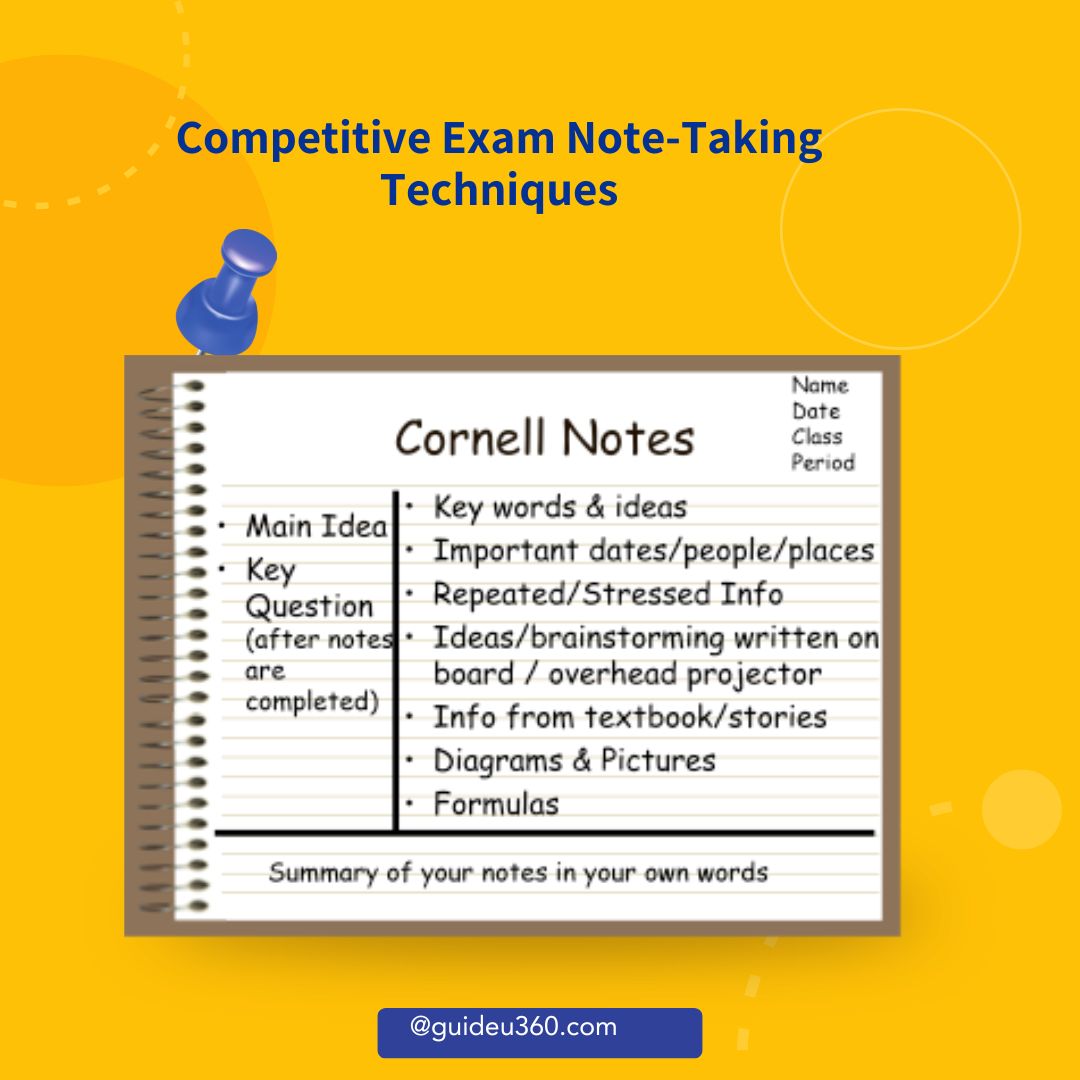Preparing for competitive exams requires more than just reading and memorizing textbooks. Effective note-taking plays a crucial role in organizing information, enhancing understanding, and making revision easier. In this post, we’ll explore some proven note-taking methods that can help you prepare efficiently for your exams.

1. The Cornell Method
The Cornell Method is a systematic format for condensing and organizing notes. This method divides your note page into three sections: a narrow left-hand column, a wider right-hand column, and a summary at the bottom.
- Main Notes (Right Column): Use this space to take detailed notes during your study sessions.
- Cue Column (Left Column): Write down key questions, terms, or concepts that will prompt your memory when revisiting the notes.
- Summary (Bottom Section): Summarize the content in your own words at the bottom of the page to reinforce your understanding.
Why It Works: This method encourages active engagement with the material, helping you retain information longer.
2. Mind Mapping
Mind mapping is a visual note-taking technique that involves creating a diagram to represent concepts and their relationships. Start with a central idea and branch out into subtopics, using lines, arrows, and images to connect ideas.
- Central Idea: Place the main topic or concept in the center.
- Branches: Draw branches for each major subtopic.
- Details: Add details, examples, and connections on smaller branches.
Why It Works: Mind maps help you see the bigger picture and understand how different concepts are interrelated, making it easier to recall information.
3. The Outline Method
The Outline Method is a hierarchical way of organizing notes, using headings and subheadings to structure information. This method is particularly effective for subjects with a lot of detail, such as history or biology.
- Main Topics: Use Roman numerals (I, II, III) for main topics.
- Subtopics: Use capital letters (A, B, C) for subtopics.
- Details: Use numbers (1, 2, 3) for supporting details or examples.
Why It Works: The Outline Method helps you organize information logically, making it easier to review and understand.
4. The Charting Method
The Charting Method involves creating tables or charts to organize information into categories. This method is particularly useful for subjects that involve comparisons, such as chemistry or economics.
- Create Columns: Label columns based on categories or themes (e.g., date, event, significance).
- Fill in Rows: Enter relevant information under each column.
Why It Works: The Charting Method allows for quick comparison of related information, making it easier to study and review large amounts of data.
5. The Sentence Method
The Sentence Method involves writing every new piece of information on a separate line, numbering each line. This method is ideal for fast-paced lectures or when reading dense material.
- Numbering: Number each sentence or piece of information.
- Brevity: Keep sentences short and to the point.
Why It Works: This method ensures you capture everything, especially in situations where information is presented quickly.

6. Digital Note-Taking Tools
In the digital age, note-taking has evolved beyond pen and paper. There are several digital tools that can help you take, organize, and review notes more effectively.
- Evernote: Organize notes with tags, notebooks, and search features.
- Microsoft OneNote: Create digital notebooks with sections and pages for different subjects.
- Google Keep: Use labels and color-coding to organize quick notes and reminders.
Why It Works: Digital tools offer flexibility, easy organization, and accessibility across devices, making them a great option for tech-savvy students.
How to stay motivated during exam preparation
7. Tips for Effective Note-Taking
- Be Consistent: Choose a note-taking method that works for you and stick to it.
- Review Regularly: Go over your notes weekly to reinforce learning and identify gaps in understanding.
- Use Abbreviations: Develop a system of abbreviations to save time and space.
- Highlight Key Points: Use different colors or symbols to highlight important information.
- Stay Organized: Keep your notes well-organized and dated for easy reference during revision.
Effective note-taking methods for competitive exams is a skill that can significantly enhance your competitive exam preparation. Whether you prefer the structured approach of the Cornell Method, the visual creativity of mind mapping, or the convenience of digital tools, there’s a method that will suit your learning style. Experiment with these techniques, find what works best for you, and watch your exam performance improve.





